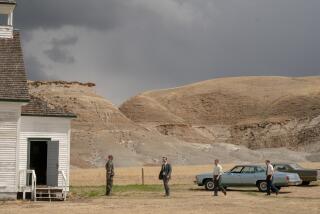Lumet’s ‘Night’ Represents Triumph of the Improbable
- Share via
Director Sidney Lumet marks his 40th year in films with his 40th movie, “Night Falls on Manhattan,” and it is gratifying to report that it’s one of his best. Significantly, he’s made nearly three-quarters of his films in Manhattan, where he became the quintessential New York director well before Woody Allen came along. As it is happens, “Night Falls” is also quintessential Lumet.
To Lumet, people count for more than fancy camera angles and special effects. He is perennially concerned that, in a corrupt world, the choices that individuals of character and principles make do in fact matter and have real-life consequences for themselves and others and even society at large.
The great thing about Lumet is that he is not cynical but instead finds an amusing irony in exploring the art of the possible, in discovering that point at which decent people in positions of power and responsibility can be capable of working together privately, of looking the other way if necessary, for the greater good of all concerned.
This is the lesson that Andy Garcia’s Sean Casey needs badly to learn. (Garcia as a character named Sean Casey? We eventually learn Sean’s late mother’s maiden name was Nun~ez.) He is the son of veteran cop Liam Casey (Ian Holm) and was a policeman himself before becoming an assistant district attorney.
A chain of events rapidly propel the younger Casey into becoming the district attorney, fiercely idealistic and seriously inexperienced. In the aftermath of the sensational case that made his career a mere eight months after becoming an assistant D.A., Casey now finds as his first order of business the related discovery of the corpse of an ex-cop turned go-between for drug kingpins and cops on the take.
*
To experience the pleasure of surprise after surprise in watching this picture, it’s clearly better not to have read Robert Daley’s “Tainted Evidence,” which Lumet adapted to the screen, or to know much about the plot. The film is a classic example of Aristotle’s belief in the dramatic power of the improbable--of how much more potent the improbable can be than the easily plausible if you can make it credible. A string of unlikely events and coincidences set off “Night Falls,” and Lumet makes them believable the old-fashioned way: through interaction with a screen full of strongly drawn, fully dimensioned, psychologically valid characters.
Along with excellence in all aspects--Mark Isham’s spare, elegiac score; David Watkin’s brooding, shadowy images; production designer Philip Rosenberg’s evocative, wide-ranging settings; Sam O’Steen’s sharp yet subtle editing--there are many richly shaded portrayals, a Lumet hallmark.
Had “Night Falls” been made 20 years ago, the role of Sean Casey most surely would have gone to Al Pacino. Yet it is hard to imagine anyone doing a finer job than Garcia in making Sean come alive in all his passion and torment. British actor Holm, who added so much pleasure to “The Fifth Element” as a priest with cosmic secrets, in “Night Falls” has one of his great screen roles as a decent, dedicated cop and loving father called upon to defend his entire career.
Alan Dershowitz himself couldn’t do a better spin on events than does Richard Dreyfuss, as a savvy liberal attorney in defending a drug kingpin/cop killer (played with unsettling, barely controlled rage by Shiek Mahmud-Bey) in what seems to be a baldly open-and-shut case.
Ron Leibman is Sean’s bombastic mentor; Colm Feore is Leibman’s WASPy, Harvard-educated antagonist; and James Gandolfini is Holm’s partner on the force of many years. Lena Olin plays a key member on Dreyfuss’ team, a worldly woman who makes her attraction to Garcia clear yet in her sophistication rightly worries that she just might not be good enough for so rigorous a man.
*
All of these actors and many others are memorable. Somehow the people in Lumet movies look more real than they do in most other director’s films, perhaps because they’re not all young or attractive. Typical of his attention to supporting players is Marcia J. Kurtz as the kind of dedicated, dependable secretary you would expect a Manhattan D.A. to have.
Anyone who has seen Lumet’s terrific 1990 “Q & A,” in which Timothy Hutton played a similarly idealistic novice assistant district attorney happening upon corruption in high places, is likely to see “Night Falls on Manhattan” as a companion film. They both take us into darkly paneled settings of power as well as dangerous streets and gemutlich old Manhattan bars.
In both instances, Lumet creates--with warmth, wisdom and humor--a vibrant world in which good and evil are in constant combat and in which possibilities in relationships between people are fluid and infinite.
The jolting opening of “Night Falls” shows how adept Lumet is at creating edge-of-your-seat suspenseful action with economy and dispatch. But the heart of the matter for Lumet is daring to take the time to let people actually talk and even listen to each other.
It’s surprising that Paramount did not release “Night Falls” when it was ready last autumn, since it is the kind of expertly crafted prestige item often held for year-end release for the Oscar race. However, as an intelligent and mature major American film, “Night Falls on Manhattan,” while hardly what one would call a summer movie, opens virtually without competition.
* MPAA rating: R, for violence and language. Times guidelines: The film is too intense and complicated for younger children but suitable for mature adolescents accompanied by adults.
(BEGIN TEXT OF INFOBOX / INFOGRAPHIC)
‘Night Falls on Manhattan’
Andy Garcia: Sean Casey
Richard Dreyfuss: Sam Vigoda
Lena Olin: Peggy Lindstrom
Ian Holm: Liam Casey
Ron Leibman: Morgenstern
Colm Feore: Elihu Harrison
A Paramount release of a Spelling Films presentation. Director Sidney Lumet. Producers Thoma Mount and Josh Kramer. Screenplay by Lumet; based upon the novel “Tainted Evidence” by Robert Daley. Cinematographer David Watkin. Editor Sam O’Steen. Costumes Joseph G. Aulisi. Music Mark Isham. Production designer Philip Rosenberg. Art director Robert Guerra. Set decorator Carolyn Cartwright. Running time: 1 hour, 53 minutes.
* In general release throughout Southern California.
More to Read
Only good movies
Get the Indie Focus newsletter, Mark Olsen's weekly guide to the world of cinema.
You may occasionally receive promotional content from the Los Angeles Times.










